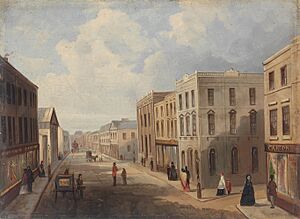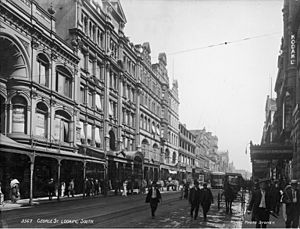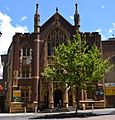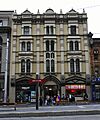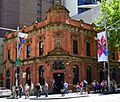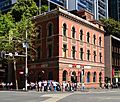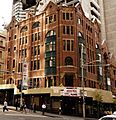George Street, Sydney facts for kids
Quick facts for kids George StreetNew South Wales |
|
|---|---|
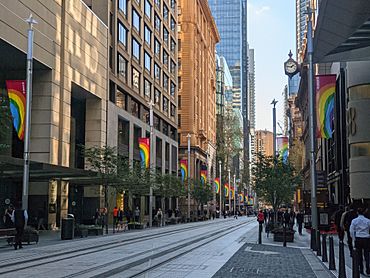 |
|
| George Street in its current state after the implementation of light rail | |
| General information | |
| Type | Street |
| Length | 3 km (1.9 mi) |
| Former route number |
(Ultimo–Town Hall) |
| Major junctions | |
| North end | Lower Fort Street Dawes Point, Sydney |
|
|
| South end | Ultimo, Sydney |
| Location(s) | |
| Suburb(s) | Sydney CBD, Haymarket |
George Street is a very important street in the heart of Sydney, Australia. It runs through the main business area, known as the CBD.
This street was Sydney's first main street, like a "High Street" in England. Today, it is still one of the busiest streets in the city. Many tall buildings and important places are found along George Street. It has more skyscrapers than any other street in Australia.
The street starts in the north, in an area called The Rocks. This is close to the famous Sydney Harbour Bridge. It then stretches south towards Central Station and Ultimo. From there, it turns into Broadway, which leads to Sydney's western suburbs.
Contents
History of George Street
George Street began when the first European settlement was built at Sydney Cove. Captain Arthur Phillip set up the first convicts and soldiers on the western side of the bay. A path was made from the convicts' camp in The Rocks. It went past the soldiers' barracks and along a stream. This path led to a brick-making area near where Central Station is now. Some people think this path followed trails already used by the local Aboriginal people.
This path, which became George Street, was one of Sydney's first two main roads. The other was Bridge Street. It's possible that George Street was the very first street in Australia.
Before 1810, George Street was often called "High Street," like a main street in England. Parts of it were also known as "Sergeant Major's Row" or "Spring Row." This was because water carriers used the route to get water from the Tank Stream. In 1810, Governor Lachlan Macquarie officially named the street after King George III.
In 1907, an important meeting happened on George Street. It was at Bateman's Crystal Hotel. At this meeting, people decided to create the New South Wales Rugby Football League. This was Australia's first professional rugby football group. It later became the National Rugby League (NRL) that we know today.
For many years, George Street was the route for Sydney's Anzac Day parade. This is a special day to remember soldiers. However, in 2016, the parade moved to Elizabeth Street. This change happened because of construction work for the new light rail system. The light rail started running through George Street in December 2019.
From 2019 to 2022, most of George Street was changed into a walking area. This means that cars can't drive on large parts of it anymore. It's now a place for people to walk and enjoy.
Exploring George Street's Areas
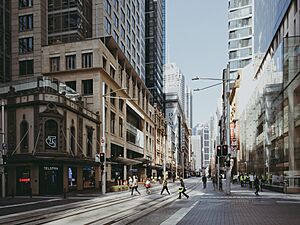
George Street is very long and goes through different parts of Sydney. Each part has its own unique feel and attractions. Let's explore them from north to south:
The Rocks: Sydney's Birthplace
At the very northern end of George Street is The Rocks. This is where the first British settlers arrived in 1788. Today, it's a popular spot for tourists. You can find many souvenir shops, restaurants, and traditional pubs here. There are also art galleries and the Museum of Contemporary Art. George Street ends here, right at Port Jackson (Sydney Harbour). From here, you can see the Sydney Harbour Bridge and the Sydney Opera House. Circular Quay railway station and ferry terminals are also nearby.
Wynyard: Business and Shopping Hub
This area of George Street is mostly filled with large office buildings. Many big companies and banks have their offices here. You'll also find shops, large hotels, and entertainment places. A key cross street here is Martin Place. This is where the Sydney Cenotaph (a war memorial) and the historic Sydney General Post Office are located. Wynyard railway station is also in this part of George Street.
Town Hall: Historic Buildings and Retail
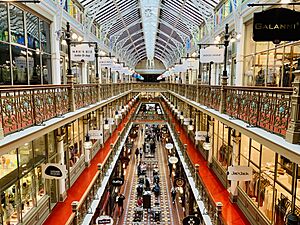
The middle section of George Street is home to three important historic buildings. These are St Andrew's Cathedral, the Sydney Town Hall, and the beautiful Queen Victoria Building shopping centre. Town Hall station is very convenient for visiting these places. Around here, you'll find many large shops, including the main Sydney store for the department store Myer. The popular Pitt Street Mall, a big shopping area, is also close by.
Cinema District: Entertainment Central
This area used to have Sydney's biggest movie theaters. Now, they are combined into one large cinema complex. The Cinema District is also known for its many video arcades, internet cafes, fast food restaurants, and pubs. It's a very lively place, especially after dark.
Chinatown: Culture and Food
Sydney's main Chinatown is located in Haymarket, near the southern end of George Street. Most of Chinatown is to the west of George Street, but it also extends to the east. It's a great place for unique shops and delicious restaurants. One special feature near George Street is a tree stump covered in gold. It's said to bring good luck to the Chinese community. The Capitol Theatre, which hosts many international musicals, is also nearby.
Railway Square: Transport Hub
The very southern end of George Street is called Railway Square. It's where several busy streets meet. It's named this because it's right next to Sydney Central station, the city's main train station. Railway Square is also a large bus stop. Today, it's surrounded by hotels and small shops. A campus of the Sydney Institute of TAFE (a college) is also located here.
Getting Around George Street
For a long time, George Street has been a major route for transport in Sydney.
Trams and Buses
In 1899, an electric tramway (like a streetcar) opened along George Street. This made it easier to travel than using horses or walking. In 1959, the trams were replaced by diesel buses. For many years, George Street was the busiest street for buses in Sydney. Most buses going to the inner western and north-western suburbs used this street.
Train Stations
Many of Sydney's main train stations are on or very close to George Street.
- At the northern end, you'll find Circular Quay station.
- Further south is Wynyard underground station. It has a big entrance on George Street.
- Next is Town Hall station, located under George Street near the Sydney Town Hall.
- At the southern end is Sydney Central station, the city's largest train station.
Light Rail Development
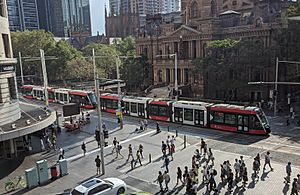
Because of too many buses in the city centre, the NSW Government decided to build a light rail system. In 2012, they announced plans for a light rail line. It would run from Circular Quay down George Street to Central station. Then it would continue east to Kensington and Randwick.
Along with the light rail, parts of George Street were turned into pedestrian-only areas. This means they are just for walking. The goal was to make George Street "Sydney's best shopping and walking street." Construction for the light rail began in October 2015, and George Street was closed for a while. The light rail officially opened on December 14, 2019.
Since then, more sections of George Street have been made into walking boulevards. This makes the street much more pleasant for people to enjoy on foot.
Famous Buildings and Architecture
-
Former Bank of NSW building
See also
 In Spanish: George Street (Sídney) para niños
In Spanish: George Street (Sídney) para niños


